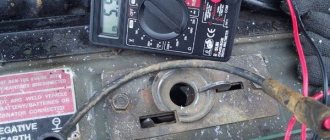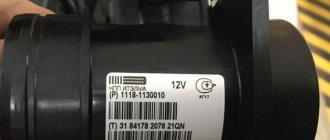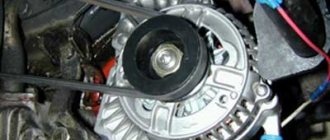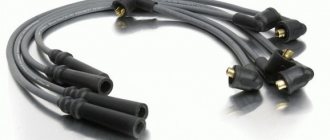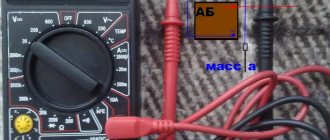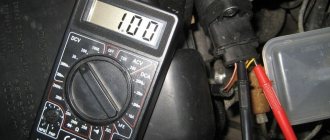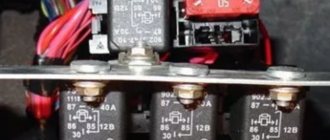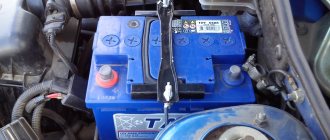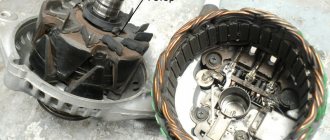What parameters can be checked?
Using a multimeter, you can measure voltage with high accuracy. By the magnitude of the electrical voltage, you can determine whether the battery is charged or the element needs to be charged with direct current.
Using a multimeter, you can check the voltage not only of acid batteries, but also of cell phone batteries. To check the mobile phone's battery charge level, the device is switched to the mode for measuring direct current up to 20 V. In this mode, the digital device allows you to measure voltage with an accuracy of hundredths of a volt.
The screwdriver battery can also be easily checked with a multimeter. The rated voltage of the device, in this case, can be found out from the documentation of the power tool, and if the voltage is less than this value, then the battery must be charged.
The battery capacity can also be checked with a multimeter. For this purpose, you can use several methods.
You can check current leakage using a multimeter. If it is necessary to measure this parameter on a car, then in addition to the current leakage on the body, the leakage in the vehicle’s on-board network is also checked.
In this way, you can prevent rapid discharge of the battery and increase its service life.
Checking battery parameters using a multimeter
To carry out measuring work, in many cases, it is impossible to do without dismantling the battery. If it is necessary to test a car battery, it should also be removed from the car.
Voltage
All batteries produce direct electric current at the terminals, so to measure it, the multimeter mode switch should be set to the DC position. The battery voltage can differ significantly depending on the type of battery, so in order to get the most accurate readings, you must correctly select the maximum voltage that the device can measure.
The multimeter switch has several modes that can be used to measure DC voltage. For most batteries, it is enough to set the limit to 20 V. Almost all AA batteries and phone batteries are capable of delivering significantly lower voltage.
The only exception to this rule is the measurement of 24 V car batteries, and some laptop batteries, which, when fully charged, can have a voltage exceeding 20 V at their terminals.
Note. In the same way, you can measure the voltage in industrial batteries or in an outlet, only in this case you need to switch the switch on the multimeter to a higher voltage, for example 200 V.
Now the value is set to 20V, but if the source voltage is higher, then you need to set it to 200 or 1000 depending on the source voltage.
When measuring, it is important to maintain polarity, that is, connect the red probe to the battery positive, and the black probe to the negative. When reversing the polarity, devices equipped with a digital display will inform you about the polarity violation with a minus sign in front of the number.
On pointer instruments, such a connection will cause the needle to move in the opposite direction, which will completely prevent correct voltage measurements. Although in general there is nothing wrong with this.
Current strength
In order to measure the current strength of a low-power battery, it is enough to switch the device to the mode for measuring this parameter (A). By touching the probes of the device to the battery terminals, you can get the exact value in milliamps.
When taking measurements on a battery of higher power, the device is switched to the “10A” position, and the positive output of the multimeter is moved to the adjacent cell.
If you need to measure the current on a car battery, then these two methods are not suitable, because the discharge current of such batteries can reach several hundred amperes. Such measurements can only be carried out using a special tester, for example, Bosch BAT-131.
Capacity
Using a multimeter, you can approximately calculate the actual battery capacity. In addition to the tester, you will need to assemble or purchase a voltage stabilizer, which must correspond to the rated voltage of the battery.
Then you should select a load that can be powered from the battery for a sufficiently long period of time. To calculate the capacity, you should also prepare a stopwatch.
The measurement process is carried out in the following sequence:
- The multimeter is switched to current measurement mode (10 A).
- The measuring device is connected in series to a circuit consisting of a current source, a voltage stabilizer and a load.
- The stopwatch starts.
After turning on the circuit, you should record the values of the multimeter, and use a stopwatch to determine the amount of time it will take to completely discharge the battery. After multiplying the current by the time, you can get the actual battery capacity, measured in amps/hours.
The use of this method for measuring the capacity of many acid batteries is not recommended, due to the negative impact of completely discharging the battery on its performance.
Example! If we know in advance that the device connected to the battery consumes 10 Ah, then depending on how many hours it works, this will be the battery capacity. If in our case the device operates for 10 hours, then the battery capacity will be 100 Amperes.
Internal resistance
Using a multimeter, you can easily measure the internal resistance of a current source. To perform this operation you must:
- Measure the voltage at the battery terminals.
- Connect the load and measure the voltage drop and current in the circuit.
- Carry out calculations using the formula R = U/I, where R is the internal resistance, U is the voltage difference at the battery terminals before and after the load is turned on, I is the current strength in the circuit.
This method is suitable for measuring almost any type of battery.
High leakage current
Leakage current
Measuring the leakage current is very simple. To determine this parameter, you need to switch the multimeter to current measurement mode, connect the negative terminal of the battery to the device, and connect the positive output of the battery to the connected cable through the tester.
The amount of leakage current will be displayed on the digital display. When measuring leakage current on a car, the multimeter should be switched to resistance measurement mode (10 A), and all electrical consumers should be turned off.
Overcharge
To determine overcharge, the multimeter should be switched to voltage measurement mode. After determining the voltage, you should compare the nominal value of the battery with those obtained as a result of the measurement. If the latter are more than 20% higher than normal, this will indicate that the battery is overcharged.
Overcharging a battery is quite dangerous. Acid batteries, in this case, begin to boil with the formation of explosive gas. Lithium-ion batteries may catch fire or explode if overcharged.
Charge level
For many types of batteries, the state of charge is checked by voltage. As in the previous case, you need to know the battery voltage at 100% charge. A fully charged lead battery should have a voltage of 12.7 volts at its terminals.
Fully charged car battery
A complete discharge of the battery will correspond to a value of 10.5 V. It is easy to determine in this way the degree of charge of the battery if the voltage readings deviate from these values.
Similarly, knowing the nominal voltage values, you can measure the voltage with a multimeter to approximately determine the state of charge of a AA battery or battery for a mobile phone or laptop computer.
| Battery voltage, V | Electrolyte density | Battery charge, % |
| 10.5 | 1.06 | 0 |
| 11.3 | 1.07 | 10 |
| 11.5 | 1.10 | 20 |
| 11.7 | 1.12 | 30 |
| 11.9 | 1.15 | 40 |
| 12.0 | 1.17 | 50 |
| 12.2 | 1.20 | 60 |
| 12.3 | 1.22 | 70 |
| 12.4 | 1.24 | 80 |
| 12.5 | 1.26 | 90 |
| 12.7 | 1.27 | 100 |
How to measure voltage
If it is necessary to check only the battery voltage, then the multimeter is switched to DC mode. If you need to check a source of electricity whose voltage does not exceed 20 volts, then in this sector the mode switch is set to the 20 V position.
Then the black probe of the multimeter should be connected to the negative terminal, and the red one to the positive terminal of the battery; the device display, at this moment, will show the DC voltage.
Typically, a serviceable and fully charged car battery has a voltage of 12.7 V. If at this voltage the electrolyte density is normal, then the source of electricity can be used for its intended purpose.
The voltage of lithium-ion batteries of cell phones, as well as alkaline or gel batteries, which are used to start the engines of various motorcycles, diesel generators and other devices that require a certain charge of electricity to start operating, is measured in a similar way.
What is a multimeter
A multimeter is a combined measuring instrument that performs the functions of several instruments:
- ammeter;
- voltmeter;
- ohmmeter.
Digital devices are popular today, but analogue ones are also relevant.
Device diagram
Before we tell you how to test a battery with a tester, let's look at the diagram of its device. The simplest diagram of the device shows 3 resistors with shunts to determine the resistance in Ohms: 0.5; 4.6; 46.3.
Device diagram
When switching to other outputs, the device determines the current strength using 3 indicators in amE: 3, 30, 300. Shunts are a kind of protection when measuring various current sizes.
The measurement of the indicator - current voltage in three ranges in V: 3, 30, 300 is carried out with additional resistors: 950 Ohm, 10 and 100 kOhm. The instrument is used exclusively for testing DC data.
What is it used for?
The multimeter is a multifunctional universal tester. It replaces three measuring instruments at once, such as an ohmmeter, a voltmeter and an ammeter, so it can be used to measure such indicators in a section of an electrical circuit as:
- Resistance.
- Voltage.
- Current strength.
Thus, the device measures direct and alternating voltage and direct current.
Note! Using this device, various radio components are checked, as well as the continuity of the electrical circuit.
How to measure capacitance
The multimeter can also be used as a tester to measure battery capacity. The battery capacity can be measured using a test battery discharge. To check the capacity, you will first need to fully charge the battery. Then you need to make sure that the battery is fully charged by measuring the voltage and density of the electrolyte.
Next, you need to connect a load of known power, for example a 24 W incandescent lamp, and note the exact start time of this experiment. When the battery voltage drops to 50% percent of the previously set reading of a fully charged battery, the light should be turned off.
Capacity measurement, which is expressed in a/h, is carried out by multiplying the current in the circuit with a connected load by the number of hours during which the control discharge of the battery was carried out. If you get a value that is as close as possible to the nominal a/h value, then the battery is in excellent condition.
Check internal resistance
To check the battery for serviceability using a multimeter, you need to measure the internal resistance of the battery. You can check the functionality of the power source using a multimeter and a powerful 12 V light bulb. You need to check the battery in the following sequence:
The 12 V lamp is connected to the battery.- After a few seconds of the lamp glowing, the voltage at the battery terminals is measured.
- The lamp turns off and the voltage is measured again.
If the measurement difference does not exceed 0.05 V, then the battery is in good condition.
In the case where the voltage drop is greater, the internal resistance of the power source will be higher, which indirectly will indicate a significant deterioration in the technical condition of the battery.
In this way, it is possible to fairly accurately check the power source for serviceability.
What is a multimeter
This is a multi-purpose electrical device with which you can measure, at a minimum, voltage, amperage and resistance level. For simplicity, it is often called a tester. Used in all areas of electronics. There are multimeters with the option of measuring even water or ambient air temperature.
Any multimeter has two wires with contacts that can be connected to different “sockets” - depending on what indicators we need to measure. It is always important to remember that the red wire is the “positive” pole , and the black wire is the negative one. The main purpose of the metal contacts at the end of the wires is to directly connect them to the terminals of the car battery.
Checking the battery charge with this device can be carried out anywhere: on the street, in the garage, at home. During testing, you can install the multimeter in a convenient place on the car. The main thing is to know the correct sequence of simple actions in order to correctly determine all the necessary indicators.
How to check leakage current
The battery may discharge on its own, even if its terminals are not connected to electrical consumers. The amount of self-discharge is indicated in the documentation for the battery and is a natural process. The loss of electricity can be especially noticeable in acid batteries.
In addition to natural electrical leakage, there may be areas of the circuit that are wet or have thin insulation. In this case, even when all electricity consumers are turned off, an additional current leak occurs, which can lead to a complete discharge of the battery, and in some cases, to a fire in the damaged area.
Especially, this phenomenon can be dangerous in the on-board network of a car, in which the negative conductor is the entire body and components, which may contain a sufficient amount of flammable substances to form an open flame even from a small spark or electric arc.
To identify such “unauthorized” consumption of electricity, it is necessary to turn off the car’s ignition, as well as turn off devices operating in “standby mode”, such as a radio and alarm system.
You can measure the current on the battery using a multimeter only if the measuring device is switched to the current measurement mode, indicated by the “10 A” icon. To do this, the circular switch is switched to the appropriate mode, and the red plug is placed in the socket marked “10 ADC”.
The red probe of the multimeter is connected to the “+” of the battery, and the black probe is connected to the disconnected terminal. At this moment, there should be no readings from the device at all. If the multimeter shows any value, then the leakage current is significant, and it is necessary to carry out a detailed diagnosis of the vehicle’s on-board network.
Leakage is measured in other electronic systems in a similar way. When carrying out diagnostics, care should be taken, and if you suspect a significant electrical leakage, which is manifested by sparking when disconnecting or connecting a terminal, you should refuse to measure the leakage current with a multimeter.
If you neglect this rule, you can “burn” the device, which is not designed to test large current values.
Verification technology
You need to do the following:
- Set the multimeter to current measurement mode (DCA) at 10 or 20 amperes.
- Install the black probe (−) into the COM socket.
- Install the red probe (+) into socket 10 ADC.
- If the test is carried out in the ground gap, then the negative terminal is removed from the battery, one of the multimeter wires is connected to it, and the other wire is connected to the battery negative. The polarity of the wires is not important here.
- If the test is carried out in the “plus” gap, then the positive terminal is removed from the battery. The negative wire of the ammeter is connected to the car terminal, and the positive wire is connected to the “+” of the battery.
Before checking, turn off all energy consumers in the car. Then, about a minute after the complete shutdown, the multimeter is connected to the open circuit. If the ammeter shows 0, then there is no current leakage, and if other readings are given, even minimal ones, it is necessary to look for the exact cause of the leakage.
To do this, sequentially and one by one, pull out and put back all the relays and fuses. This way it will become known for certain what the “weak link” is.
It is necessary to be vigilant: if sparks appear even at the moment of removing the terminals from the battery, then checking with a conventional multimeter is quite dangerous - there is a risk of burning the device.
